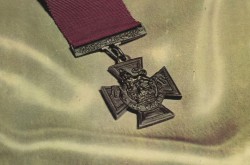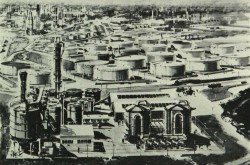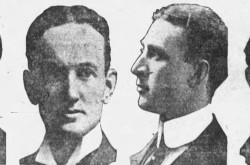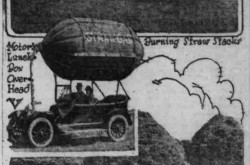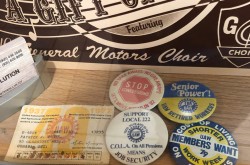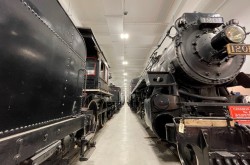Behind the scenes: Conservators face unique task handling hazardous artifacts
With work well underway to move the national science and technology collection to the new Collections Conservation Centre, Ingenium conservation staff are dealing with some curious artifacts that need some extra attention.
Museum Conservator Erin Secord is one of Ingenium’s resident experts when it comes to handling hazardous artifacts. She’s quick to point out the unique nature of the collection, which spans the Canada Agriculture and Food Museum, the Canada Aviation and Space Museum, and the Canada Science and Technology Museum.
“Having been a technological, historical, scientific, industry, and agricultural collection, it is just laden with all sorts of hazards you may not find — to the same extent — in a typical art gallery or other museums,” says Secord. “The things we have were made with hazardous materials or used in hazardous environments; therefore, they come to the collection with hazardous traces.”
Some artifacts from the Canada Agriculture and Food Museum may have remnants of pesticides or other harmful substances. Artifacts from the Canada Science and Technology Museum may be old medicines or chemicals, which could be potentially toxic. Being as large as they are, many artifacts from the Canada Aviation and Space Museum pose a hazard simply because of their size.
Telling the whole story
Although the collection may have its fair share of hazards, Secord says the rich variety of the artifacts in the collection means Ingenium museums can better tell the story — not only behind the artifacts, but also behind the people who have used them.
“We’re actually very lucky to be able to have these things because we’re able to tell the whole story of the artifact,” says Secord. “Not just have it sitting statically on the floor, but all the things a user or an operator may interact with as they’re experiencing this artifact in their day-to-day life.”
Through this massive moving project, the artifacts will be moved into more ideal facilities in the new building. Secord says this will allow for improved access to the artifacts.
“We’re taking all the steps necessary to not only preserve the collection in the new Collections Conservation Centre building, but to protect the people who are going to access the collection, and to make these artifacts safe for more in-depth and enriched access in the new Collections Conservation Centre,” says Secord.
Everyday hazards
Hazards aren't always apparent; artifacts that may seem harmless and safe can actually have some pretty hazardous qualities. A trained eye, and a strong knowledge of the collection, are vital.
“Even things you might not even appreciate are hazardous, there is some astrophysics equipment that contained hydrofluoric acid when it was used,” explains Secord. “But we would only know that by investigating the history of the instrument. So if we see something dripping out of the artifact, we will know that it’s hydrofluoric acid and not just innocuous water.”
When they’re in storage, everyday items that we take for granted and consider to be safe can become potential hazards.
“We think of batteries of being something that we come across every day, but as batteries age and deteriorate they actually give off quite a bit of corrosive material,” explains Secord.
She says they check for batteries in artifacts and deal with them accordingly. Another potentially hazardous everyday item in the collection that Secord points out are fire extinguishers. Ingenium has quite an extensive collection of fire extinguishers and these all have to be properly labeled as artifacts — as to not confuse firefighters in case of an emergency — and some of the older fire extinguishers actually contain toxic chemicals that were once used to put out fires.

This is an example of an artifact that the conservators are planning to dispose of, since the hazardous contents have deteriorated the artifact too much. Conservators try their best to not dispose of any artifacts; typically they only do so if they have a copy of the same artifact in better condition.
A safe and conscious way
Secord and the team of conservators at Ingenium have developed a process for packing and labeling these hazardous artifacts in a safe and conscious way.
First, a search is conducted for artifacts with a specific hazardous trait; for example, artifacts containing mercury. A conservator will go and physically look in storage for artifacts containing mercury. The artifact will be brought back to the packing area, and background research will be done to see what necessary precautions and equipment will be used in the packing process. In the case of mercury, it can’t come into contact with any metal, so the conservators have chosen to use a polypropylene bin. In the packing process, the conservators also use archival-grade packing materials to keep the artifact stable. This is to make sure the artifact won't break during the move and storage in the Collections Conservation Centre, which is currently under construction next to the Canada Science and Technology Museum.
“This process also creates, in this case, a small environment to manage the risk,” says Secord. “The conservator, in this case, has mercury vapor indicators in there, so that a future person coming to investigate this will be able to have a sense of whether or not something has broken, or whether or not there is a risk of mercury vapor inhalation and whether we need to consult further hazard management experts”
Secord and the other conservators also use a labeling system that incorporates the Globally Harmonized System for artifacts with specific hazards. For example, they have labels for artifacts containing oil and grease, mould, split rim tires, potassium, iodide, and lidocaine.

These are just some of the labeled tabs in the filing system. In the individual folders, there are instructions and labels in regards to the specific hazard.
The frontier of conservation
Within a unique collection comes a unique set of challenges. In many cases, the artifacts the Ingenium team is dealing with have been discontinued or heavily regulated for decades, making the handling procedures somewhat difficult. At times, Secord and her team have to forge through with the best knowledge they have on an artifacts handling.
“People aren't able to give us very specific feedback on what to do; we have to adapt with what the best practises are at the time and how to best serve the collection,” says Secord. “Especially when we come across things like split rim tires. People say, ‘Oh well, DDT is not used anymore, so don’t worry about it.’ But we still have it in our collection and it is still a source of worry for us.”
Although the conservation staff is highly trained, Secord points out that there are still gaps between conservation knowledge and industrial expertise and they continue to work with experts to close this gap.

Erin Secord browses through the filing system to find the corresponding labels for hazardous artifacts in the national science and technology collection.









